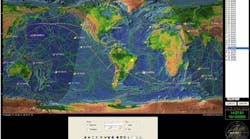As with any major industry, analytics plays a major role— mainly, a company must effectively process incoming data to be successful. The same is true for machine-to-machine (M2M) analytics, a market which is expected to grow 53.1% over the next five years. The forecasted growth from $1.9 billion in 2013 to $14.3 billion includes revenue segmentation over five key component areas: data integration, data storage, core analytics, data presentation, and associated professional services.
In the ABI Research report, “Big Data and Analytics in M2M Services,” the rise of predictive analytics is described as the greatest value catalyst to the final, prescriptive phase of analytics. Analytics-driven businesses are also working to make previously opaque physical assets part of the digital data universe, subsequently creating a synergetic relationship within the industry. Companies such as SAP and IBM have recognized the opportunity, as well as younger data management players including Splunk, Mtell, and Grok.
Another key player in the M2M industry has been ORBCOMM, a global provider of solutions including a network of low-earth-orbit (LEO) satellites, an accompanying ground infrastructure, a two-way data communications services track, and monitoring and control services. The firm serves five core markets: commercial transportation, heavy equipment, industrial fixed assets, marine, and homeland security. As part of a $200 million expansion program, ORBCOMM is set to launch 18 next-generation OG2 satellites in order to provide more coverage. The OG2 satellites also have reduced latency, smaller antennas, reduced power consumption, increased data rates, and increased message payload size to provide a more cost-effective solution. The satellites utilize frequencies of 137 to 138 MHz for receive signals and 148 to 150 MHz for transmit signals.
ORBCOMM’s portfolio of products in conjunction with their satellites helps transportation companies monitor all types of cargo assets. Recently, the GT 1100 trailer tracking solution was commercially launched as the company’s first self-powered M2M asset tracking and monitoring solution. The GT 1100’s compact form factor and low, one-inch high profile make it easy to install on trailer roof tops or in between the corrugations of intermodal containers. It also utilizes solar recharging technology for low power consumption, efficient messaging, and long service life. The versatile communications platform allows users to build their messaging schedules around their business requirements without restrictions or added costs, providing the necessary flexibility that comes with greater trailer visibility and utilization. The GT 1100 can support as many as three modes of global communication: cellular, satellite, and dual-mode (which blends cellular and satellite capability) operation.
The GT 1100 system also includes ORBCOMM’S CargoWatch, a web application that provides comprehensive device management. CargoWatch delivers near-real-time alerts on trailer status, location, history, and arrival and departure events— all of which aim to improve operational efficiency as well as a decrease in fuel consumption, maintenance costs, and theft. This is due in part to the GT 1100’s sensor compatibility, which includes a suite of support sensors for monitoring key asset parameters, such as cargo, fuel, door open/close, and hook/unhook status. For use in its dry van and flatbed trailers, Ryder, a Fortune 500 commercial transportation, logistics, and supply chain management solutions company, has already implemented 2,000 GT 1100 systems.
With companies working to make the analytics business more transparent, the need for viable solutions is only becoming more of a demand. The adoption of tracking solutions has led to a need for equally usable management services that can do something effective with the influx of data. Essentially, all of the ingredients to bake the cake are in the kitchen, and now companies are working to put them all together— although more and more people keep RSVP’ing to the party.
